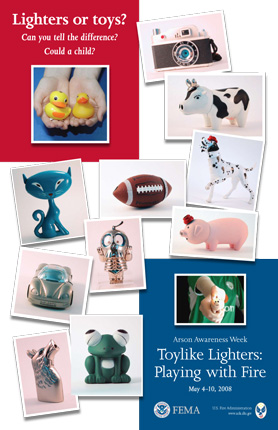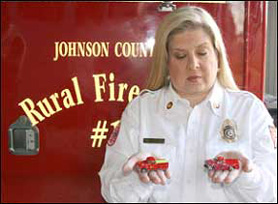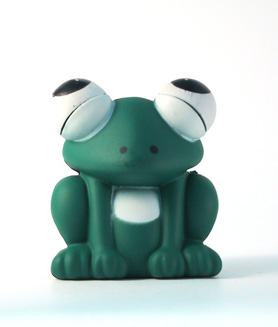Arson Awareness Week May 4-10, 2008
Toylike Lighters – Playing with Fire
The goal of this year's Arson Awareness Week is to focus public attention on the dangers of toylike or novelty lighters in the hands of children.

2008 Arson Awareness Week Poster
Download
Toylike or novelty lighters have been responsible for injuries, deaths, and accidents across the Nation. Children are attracted to novelty lighters because they look like toys. Many of these lighters look like animals, miniature cars, mobile phones, cameras, fishing lures, stacks of coins, markers, and doll accessories. One lighter is nearly identical to the popular rubber ducky bath toy—it even quacks! There are also toylike and novelty lighters that look like tools such as tape measures, drills, hammers, and paint brushes. Ironically, there are even lighters that mimic a Dalmatian donning a fire helmet, a red fire truck, or fire extinguishers.
Children Killed and Injured
Mistaking lighters for toys has proved to be deadly: on September 25, 2007, 15-month-old Peyton Edwards and 2-year-old Breydon Edwards of Russellville, Arkansas, died after setting fire to their apartment with a motorcycle-shaped lighter.

Johnson County RFD 1 Public Fire and Life Safety Educator Dayna Hilton holds two model fire trucks in her hand - could you tell which one is a toy and which is a lighter? Could a child?
Shane St. Pierre was in grocery store in Livermore, Maine, last June with his mother buying sandwiches. Thinking it might be a flashlight, the 6-year-old picked up a miniature baseball bat and flicked the switch. A flame shot out, singeing his eyebrow and burning part of his face. His father, Norm St. Pierre, a fire chief in nearby West Paris, became an advocate for a ban on toylike and novelty lighters. Maine passed a ban on toylike lighters on March 14, 2008.
Children are not the only ones fooled by novelty lighters. Beaverton, Michigan, resident Laura Fowler purchased a novelty lighter for her 4-year-old child after mistaking it for a toy. In 2006, a South Carolina woman shot herself in the hand while attempting to light a cigarette with what she thought was a pistol-shaped novelty lighter.
A fire marshal in Wisconsin was making a purchase at a local home improvement store when his 12-year-old daughter picked up what she believed was a tape measure. When she clicked the button on the tape measure, a flame came out. Fortunately, the child was not hurt, and the store owner voluntarily stopped selling the lighters.
In North Carolina, a 6-year-old boy sustained second-degree burns after playing with a lighter that looked like a toy cell phone. In Maryland, playground equipment was set on fire by three 5-year-old girls using a gun-shaped lighter. In Oregon, one child died and another was permanently brain damaged after a 6-year-old, playing with a lighter that looked like a toy dolphin, started a fire. In another incident, a mother was severely burned after her child, playing with a lighter that resembled a Christmas tree, ignited the mother's bed.
Toylike and Novelty Lighter Legislation

Google-Eyed Frog Novelty Lighter
Some local and State governments are taking action by banning the sale of toylike and novelty lighters, and limiting their distribution. Maine was the first State to pass a ban on toylike and novelty lighters, passing the legislation on March 14, 2008. Tennessee also passed a ban, in April 2008. Other states considering bans are Alabama, Connecticut, Iowa, Michigan, Ohio, Oregon, and Vermont. In addition to state bans and restrictions on the sale of toylike and novelty lighters, numerous local jurisdictions have passed ordinances. These include more than 19 jurisdictions in Arkansas, another 6 in California, and Yakima County in Washington State.
Download
State and Local Legislation
 State of Maine Act (PDF, 19 Kb)
State of Maine Act (PDF, 19 Kb) Highland, CA Ordinance (PDF, 19 Kb)
Highland, CA Ordinance (PDF, 19 Kb) North Little Rock, AR Ordinance (PDF, 23 Kb)
North Little Rock, AR Ordinance (PDF, 23 Kb) Yakima, WA Ordinance (PDF, 21 Kb)
Yakima, WA Ordinance (PDF, 21 Kb)
European Union Takes Action on Novelty Lighters
On May 11, 2006, the European Consumer Protection Commission adopted a decision requiring Member States to ensure that, from March 11, 2007, cigarette lighters are child-resistant when placed on the EU market. The decision also prohibits placing lighters on the market that resemble objects that are particularly attractive to children, so-called novelty lighters. According to the European Standard, a lighter shall not be novelty-like, because the inherent risk is significantly higher. The novelty lighters are attractive for children and, taking into account children's normal behavior, risk of burning injury is present during their use. "It's now time for the U.S. Consumer Product Safety Commission (CPSC) to follow suit," said the National Association of State Fire Marshals in a recently passed resolution. As Oregon State Fire Marshal Nancy Orr wrote to the CPSC, "There are no good reasons that lighters should be manufactured to resemble toys."
Eleven-year-old "Lighter-Fighter" in Alabama
“They look like toys so kids play with them and get burned.”
Eleven-year-old Gwin Elementary School 5th Grader David Brooks from Hoover, Alabama, has gained notoriety for what was originally a simple service project. "It's been a lot of work and a lot of fun," Brooks said. He refers to his quest to educate the public on the dangers of toylike lighters; an effort Brooks has been working on for months now. He is known as the "lighter-fighter." Brooks recently sent out dozens of letters to fire chiefs across Alabama, urging support of his project. "They look like toys so kids play with them and get burned," Brooks said in a recent Hot Issues, a publication from the Oregon Office of State Fire Marshal. Brooks has partnered with the Hoover Fire Department, the Alabama Fire College Risk Watch Program, the Alabama State Fire Marshal's Office, the Alabama Fire Marshal's Association, and the Alabama Fire and Life Safety Educators Association to spread the word about these lighters. He's also spoken to numerous community groups including the Hoover City Council, the Central Alabama Fire Marshal's Association, the Alabama Fire Chiefs Association Conference, and several fire departments around the state.
U.S. Fire Administration Adds Novelty Lighter Code to NFIRS
Effective January 1, 2008, the U.S. Fire Administration's (USFA's) National Fire Incident Reporting System (NFIRS) will collect information specifically about novelty and toylike lighters. Novelty and toylike lighters will be captured in the Fire Module under a new code for Equipment Involved in Ignition, Code 877. The descriptor for Code 877 is Novelty Lighter. The Heat Source generally will be Lighter: Cigarette or Cigar Lighter, Code 65.
NFIRS data indicate that lighters play a role nearly equal to matches in residential child-play fires, and some studies show that lighters tend to be the preferred ignition source. When children set fires in the home, the most common area of fire origin is the bedroom, and the material ignited is often bedding, mattresses, or clothing.
Intentionally set fires are the major cause of dollar losses from fires and a leading cause of fire deaths in the United States. According to 2005 data, the National Fire Protection Association (NFPA) estimates some 323,900 fires were intentionally set. In 2002, the NFPA estimated 13,900 child-playing structure fires were reported in the U.S., with associated losses of 210 civilian deaths, 1,250 civilian injuries, and $339 million in direct damage. Most child-playing home fires are started with lighters or matches. The median age of children who start reported fires by playing is 5 years old, compared to a median age of 4 years old for fatal victims, and a median age in the late teens for nonfatal injuries.
Related Topics
Related Publications (Download, Help)
 Juvenile Firesetting – A Growing Concern (PDF, 383 Kb)
Juvenile Firesetting – A Growing Concern (PDF, 383 Kb)

